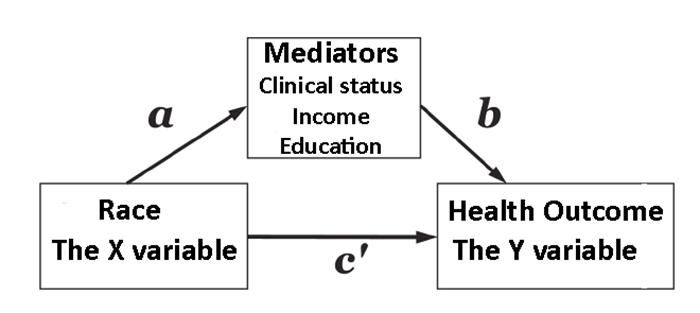“Mediators explain how an intervention works.”
Mediation analysis is a statistical technique, part of the family of regression analysis which searches for relationships between two or more variables. Specifically, mediation analysis seeks to tease out the relative impact or lack of impact of a variable on outcome. It lends greater or lesser certainty to the role of a variable in a chain of associations between an intervention and outcome. It does not determine or quantify causality.

Let’s consider the simplest application involving two familiar variables. The graphic is an adaptation taken from a study I recently discussed. The X variable is an individual’s race, and the Y variable, is the health outcome, in the study it was whether an MRI was ordered. intervention is eating a healthy diet, the outcome, good health. There are many other characteristics that are often associated and discussed when considering these racial disparities, the clinical status at the time of diagnosis, income, and educational level are examples but there can be many more. Mediation analysis tries to quantify how one or more of these fellow travelers can mediate the association we see between, in this example, race and a particular health outcome
Mediators, moderators, confounders, and assumptions
“…the main characteristic of a mediator that differentiates it from other third variable effects is that it is in a causal sequence such that the relation of X to Y is transmitted by the mediator.” [emphasis added]
In developing a theoretical causal sequence, not all the additional variables between X and Y are mediators. A mediator must be influenced by X and in turn, the mediator must go on to influence Y. All the variables in the graphic meet that definition. A moderator results in a very different statistical relationship between the X and Y or in our example race and outcome. For example, another study again looking at race and health outcomes found that US-born Blacks were more than twice as likely to experience a pre-term birth as non-US-born Blacks. In this instance, the same variable takes on a different role. As with any model including a theoretical causal sequence, content and data make a difference. The more common type of third variable is the confounder which influences outcome but also can impact that X variable, the intervention. Using our present example, a lower income could result in less access to care; but a lower income cannot alter your race; nor can your level or education or clinical status. A confounder is not in the causal chain.
Mediation analysis requires several critical assumptions, beginning with a hypothesis of the causal links between intervention and outcome. Each of these assumptions is considered in a stepwise manner in the analysis.
- First, there must be an association between the intervention and the outcome without consideration of any other variables. Without that, there is nothing to mediate. This is most frequently addressed by researchers in citing prior work demonstrating the relationship.
- Second, there must be a linkage between the intervention and the mediator, and the mediator to the outcome. If the “mediator” has no relationship it cannot mediate. Prior work provides a basis for assuming a role of the mediator in the causal chain. The data of the study provide the mediation analysis’s quantification by comparing the effect of the intervention on outcome by itself, and the effect of the intervention and mediator upon the outcome.
- If the mediator has no effect on outcome, it plays no role.
- In general, the inclusion of the mediator reduces the impact of the intervention on the outcome, and it is this degree of reduction that reflects the contribution of the mediator.
- If the inclusion of the mediator totally removes the effect of the intervention on the outcome, the mediator, not the intervention is the real driver in the causal chain – this is rarely the case.
- Finally, an additional statistical test is applied to determine whether the results are by chance or statistically significant. Despite my use of the term causal chain, the conclusions, as with all regressions, reflect associations, not causes.
What can mediation analysis tell us?
Most importantly it provides us with information on how an intervention changes an outcome. This is critical for developing helpful health policies and regulations. It is a statistical means of identifying the levers of change and directing our energy, as well as social and financial capital. Some levers are very effective but too hard to implement, others less effective, but low-hanging fruit. Mediation analysis informs our choice. For example, alcohol, in excess, can be bad for your health. Reducing the availability of alcohol will improve our health. The most effective mediator is banning alcohol, but as we learned from the 18th Amendment, it is very difficult to apply. Taxation and age restrictions are less effective, but more easily applied mediators and those are the ones we employ.
Consider a more contemporary and controversial concern, gun violence. Now if you search for mediation analysis and gun violence you will find studies on mediation, negotiation, between gangs nothing on the variables we should be considering. That is because until a year ago federal funds were not available to look at the problem. [1]
Our regulatory policy has been to reduce gun availability, which has raised concerns, well more than concerns, from gun owners fearing that regulation is more like the 18th Amendment than the age or taxation we apply to alcohol or cigarettes. But here are a few “fun” facts courtesy of the US Department of Justice’s Bureau of Justice Statistics.
- Roughly 25% of all prisoners in State and Federal facilities used a gun in the commission of their violent crimes
- Among those prisoners, more than 90% did not obtain those firearms through a retail store or gun show. That would suggest that these weapons were either stolen or the subject of private sales [2]
Increasing gun regulations seems on its surface, to hold little power over the criminal use of firearms. A mediation analysis would tell us exactly how great an impact those regulations have and might let us focus on more effective means of gun control that do not raise unnecessary hackles and cause us to waste our social energy on regulations that are more theater than effective.
[1] This was due to the passage of the Dickey Amendment, named after Congressman Jay Dickey in 1996 barring the “CDC from spending money to ‘advocate or promote gun control.’” In an interesting twist of fate, the restoration of money was spearheaded by Dickey’s widow and the scientists most impacted by the Dickey Amendment, Dr. Mark Rosenberg formerly of the CDC’s National Center for Injury Prevention and Control.
[2] Statistics are hard to come by, but you can find a bit more information here. Interestingly, at least from my perspective, is that only a handful of states require a gun owner to report a gun theft. Licensed dealers report losses of about 12,000 guns, estimates of weapons “lost” by private owners is roughly 300,000 weapons
Sources: Statistical analysis for identifying mediating variables in public health dentistry interventions Journal of Public Health Dentistry DOI: 10.1111/j.1752-7325.2011.00252.x




